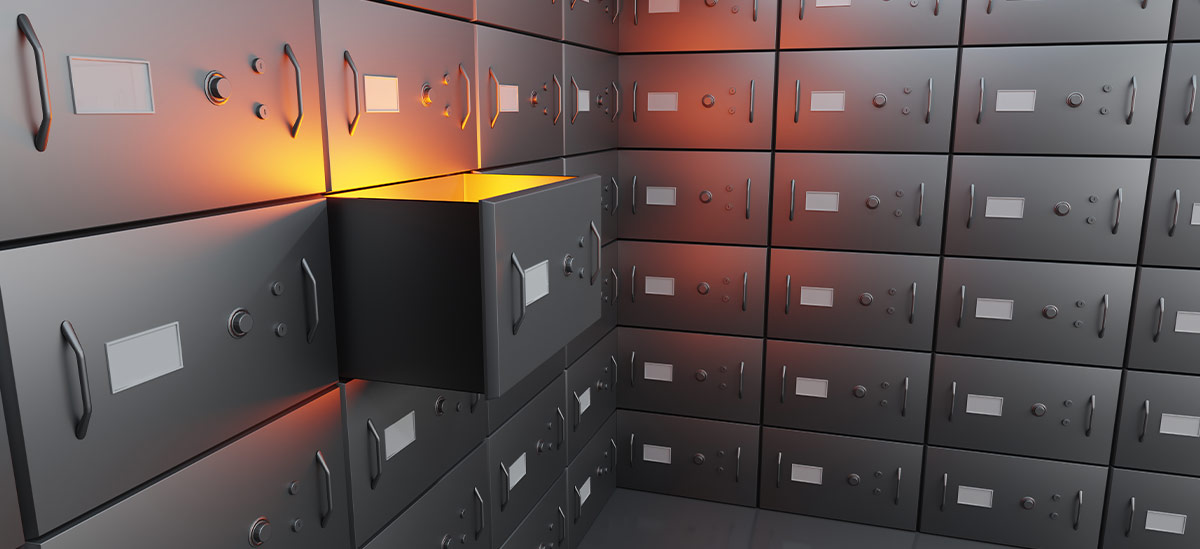
Due to the increased popularity of online banking, safe deposit boxes aren't quite as common as they once were[1]. However, there are still occasions when renting a safe deposit box (sometimes also referred to as a "safety deposit box") makes sense.
We’ll explain the basics of this storage option, including what is a safe deposit box, how safe deposit boxes work, and do's and don'ts for selecting what to store in your rental.
Safe Deposit Boxes Explained
A safe deposit box is a locked box located in the vault or safe of a brick-and-mortar bank or credit union. Customers often rent a safe deposit box from the bank to store valuables for a fee. Typically, these include personal documents, family heirlooms, stamp or coin collections, and other irreplaceable or hard-to-find items.
The rental fees for safe deposit boxes vary by bank. You can expect to pay around $10 to $50 per year for a small box measuring 3 inches by 5 inches.
On the other hand, a larger safe deposit box that measures 10 inches by 10 inches may run more than a hundred dollars per year. Your bank may offer a discount on a safe deposit box rental if you already have a checking or savings account with the institution.
In return for the fee, banks provide security measures to protect the safe deposit boxes. Unlike checking or savings accounts, safe deposit boxes are not protected by the Federal Deposit Insurance Corporation. (FDIC). So, there's always the risk — albeit low — of losing the contents of your unit due to theft or damage[2]. However, it's possible to purchase coverage for a safe deposit box through some homeowner's and renter's insurance policies.
What Is a Safe Deposit Box?
To rent a safe deposit box, visit a local branch office of your bank or credit union. Note that not all branches have safe deposit boxes, so call ahead to confirm availability. Be sure to bring along government-issued photo identification, such as a driver's license or passport. In addition, if you plan to allow another person access to your safe deposit box, you'll need to bring them along. However, you can always add another safe deposit box lessee at a later date, too — they will need to accompany you (along with their photo ID) to sign a form that adds them to the lease.
The bank will review the terms of the rental with you, and you'll sign a safe deposit box lease agreement. You'll then likely receive a key to the safe deposit box. However, recently, some banks have switched to more high-tech keyless security measures, such as fingerprint scans.
Every time you wish to access your safe deposit box, be sure to bring along your photo ID, as well as your key. In addition, it's likely that the bank will require your signature before allowing you to open your box.
When you wish to close your safe deposit box, inform the bank. If you neglect to pay the rent on your safe deposit box, the bank will likely consider it abandoned and turn over the contents to the state in compliance with that state’s escheatment laws.
Who Can Access a Safe Deposit Box?
Only you, anyone you designate to be a co-lessee on your safe deposit box, and authorized bank employees can access its contents.
When you open a safe deposit box, the bank will keep a second key, called the "guard key," in case an authorized employee needs to access the box. The bank should open the box without you only if it's required by a court order or a search warrant, if you stop paying your safe deposit box rent, or if the branch closes[3].
What Types of Items Are Typically Kept in a Safe Deposit Box?
A safe deposit box is a good place to keep important documents, as well as family heirlooms such as jewelry and collections of small items such as stamps or coins. Here are some of the most popular items kept in safe deposit boxes:
- Birth certificates
- Marriage licenses and certificates
- Citizenship paperwork
- Military discharge paperwork
- House deeds
- Car titles
- Bond certificates
- Copies of wills
- Copies of powers of attorney
- Copies of medical directives
- Business contracts
- Coin collections
- Stamp collections
- Heirloom jewelry
- Family keepsakes
Items To Avoid Putting in a Safe Deposit Box
When you rent a safe deposit box, you won't have a whole lot of real estate — typically, the largest boxes measure 10 inches tall, 10 inches wide, and 2 feet deep. Obviously, it's best not to store bulky or large items in the safe deposit box.
It's also important to keep in mind that safe deposit boxes can only be accessed when the bank branch is open.
So, it's not a good idea to keep items that you may need to grab in a hurry, such as a medical directive document or passport. (At the same time, it can be a wise decision to keep copies of important documents in a safe deposit box).
Also, keep in mind that although safe deposit boxes are usually built to withstand extreme conditions, there's still a possibility that the contents of your box could be lost in the case of a flood, fire, or other disaster. Therefore, it's best not to put anything you absolutely can't afford to lose in your safe deposit box.
Finally, never store anything illegal in a safe deposit box.
Although it might be tempting to keep some cash in your safe deposit box, it can be better to put it in an interest-bearing savings account at the bank. This way, your money can grow, and you'll benefit from FDIC insurance.




